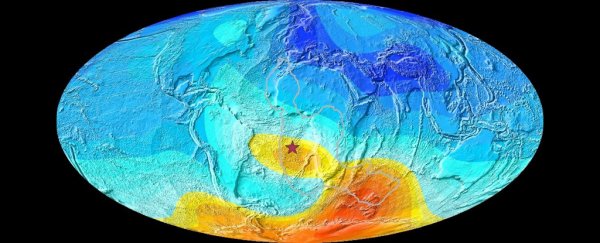For years, scientists have been gripped by the existence of a strange anomaly weakening Earth's magnetic field. It's located in the midst of the South Atlantic ocean, extending all the way from South America to the west coast of southern Africa.
This giant, puzzling expanse of reduced magnetic intensity – which in recent times looks to be splitting into two divided entities – means the region offers less protection against harmful radiation from the Sun for Earth's satellites.
That's a problem for spacecraft today. But perhaps the greatest significance of the 'South Atlantic Anomaly' is what it might mean for tomorrow: specifically, whether the mysterious phenomenon foreshadows the beginnings of a complete polar reversal of Earth's magnetic field.
Such giant magnetic flips have occurred many times in our planet's history, and some scientists have speculated that the South Atlantic Anomaly could be a kind of precursor to these rare global transitions.
Not so, according to a new study from researchers at the University of Liverpool in the UK. The alternative explanation they have is, in some ways, even stranger: the South Atlantic Anomaly is not so much a freak irregularity of recent history, but a recurrent magnetic phenomenon that has affected Earth since as far back as 11 million years ago.
"Our study provides the first long-term analysis of the magnetic field in this region dating back millions of years," says first author and palaeomagnetism researcher Yael Engbers.
"It reveals that the anomaly in the magnetic field in the South Atlantic is not a one-off, similar anomalies existed eight to 11 million years ago."
To investigate the anomaly's ancient pedigree, Engbers and her team investigated hundreds of volcanic rocks sourced from the island of Saint Helena, which lies within the South Atlantic Ocean, roughly halfway between the coasts of Brazil and Namibia – very much in the midst of the anomaly, both now and millions of years ago.
These rock samples, produced in lava flows from a number of eruptions that occurred between eight and 11 million years ago, preserve an ancient record of magnetic data inscribed at the time of their creation, which still exists to this day.
"When volcanic rocks cool down, small grains of iron-oxide in them get magnetised and therefore save the direction and strength of Earth's magnetic field at that time and place," Engbers and co-author Andrew Biggin explain at The Conversation.
"We collected some of those rocks and brought them back to our lab in Liverpool, where we carried out experiments to find out what the magnetic field was like at the time of eruption."
The tests revealed that instabilities and directional abnormalities in Earth's magnetic field in this region millions of years ago were similar to what we see today.
Similar methods looking at ancient African clay from about 1,000 years ago had previously suggested the South Atlantic Anomaly had roots in the distant past – but we've never examined it across geological timescales before.
"Our results support recent studies arguing for the long-lived recurrence of anomalous behaviour in the South Atlantic region but extend the associated timeframe from thousands to millions of years," the researchers write in their paper.
According to the researchers, the evidence therefore suggests the South Atlantic is historically a "locus of unusual geomagnetic behaviour", and one which appears to be distinct from magnetic field flips – arguably lowering the likelihood that what we're seeing today is a signal of an imminent global polarity reversal.
As for what's causing this seemingly eternal glitch in our planet's magnetic field, scientists aren't entirely sure. One previous suggestion involves a vast region of dense rock called the African Large Low Shear Velocity Province, sitting at the intersection of Earth's core and mantle, deep inside the planet.
In the new paper, the team also cites another hypothesis, which holds the anomaly may be part of a "planetary-scale eccentric gyre" in Earth's outer core, producing abnormal effects in our planet's core-mantle boundary.
It's hard to know for sure which hypothesis will come out on top. All we know is that the secrets to this strangeness lie very deep, and can be traced back further than anybody realised.
The findings are reported in PNAS.
